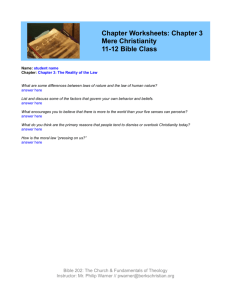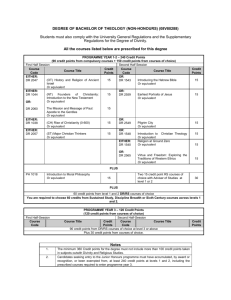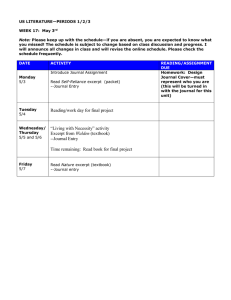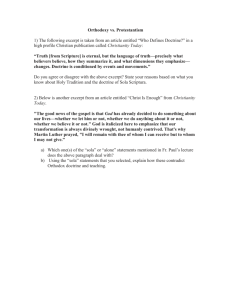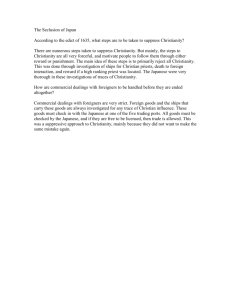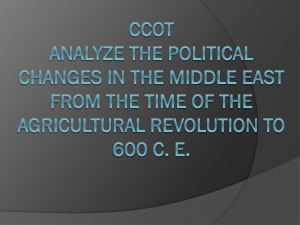New CRS THEO 311 History of Christianity II
advertisement
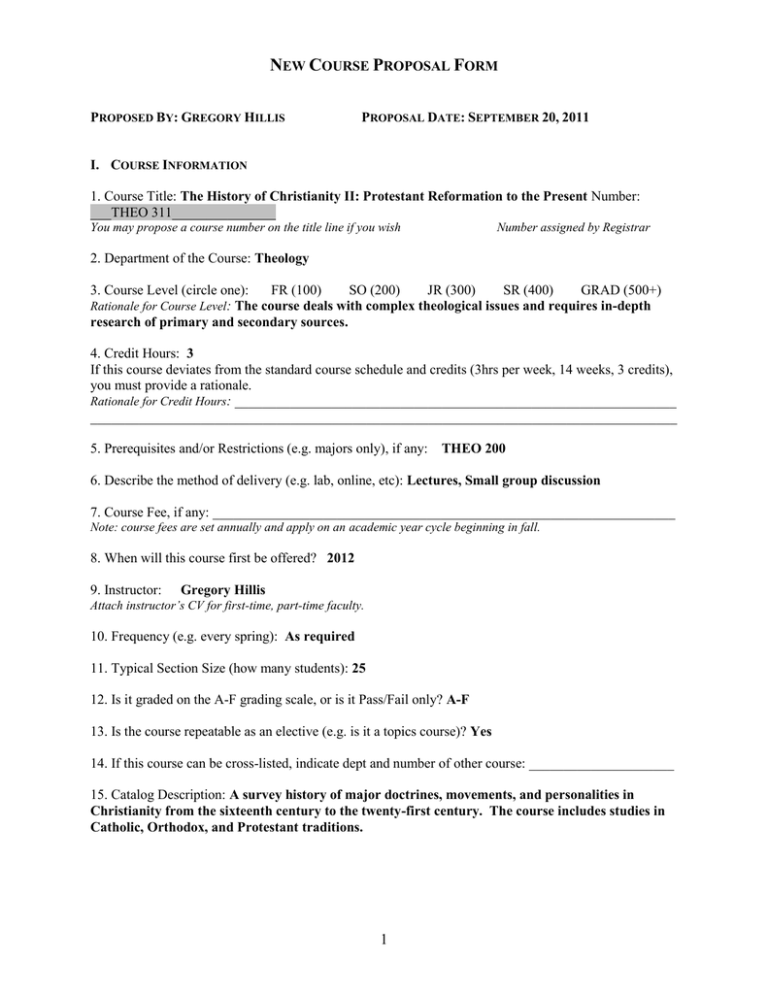
NEW COURSE PROPOSAL FORM PROPOSED BY: GREGORY HILLIS PROPOSAL DATE: SEPTEMBER 20, 2011 I. COURSE INFORMATION 1. Course Title: The History of Christianity II: Protestant Reformation to the Present Number: ___THEO 311_______________ You may propose a course number on the title line if you wish Number assigned by Registrar 2. Department of the Course: Theology 3. Course Level (circle one): FR (100) SO (200) JR (300) SR (400) GRAD (500+) Rationale for Course Level: The course deals with complex theological issues and requires in-depth research of primary and secondary sources. 4. Credit Hours: 3 If this course deviates from the standard course schedule and credits (3hrs per week, 14 weeks, 3 credits), you must provide a rationale. Rationale for Credit Hours: ________________________________________________________________ _____________________________________________________________________________________ 5. Prerequisites and/or Restrictions (e.g. majors only), if any: THEO 200 6. Describe the method of delivery (e.g. lab, online, etc): Lectures, Small group discussion 7. Course Fee, if any: ___________________________________________________________________ Note: course fees are set annually and apply on an academic year cycle beginning in fall. 8. When will this course first be offered? 2012 9. Instructor: Gregory Hillis Attach instructor’s CV for first-time, part-time faculty. 10. Frequency (e.g. every spring): As required 11. Typical Section Size (how many students): 25 12. Is it graded on the A-F grading scale, or is it Pass/Fail only? A-F 13. Is the course repeatable as an elective (e.g. is it a topics course)? Yes 14. If this course can be cross-listed, indicate dept and number of other course: _____________________ 15. Catalog Description: A survey history of major doctrines, movements, and personalities in Christianity from the sixteenth century to the twenty-first century. The course includes studies in Catholic, Orthodox, and Protestant traditions. 1 II. RATIONALE, CURRICULAR IMPACT, AND ASSESSMENT 1. Rationale for the introduction of the course: At present THEO 310 is intended to cover all twenty centuries of Christian history. This is very difficult to do in an academically responsible and pedagogically beneficial manner. Splitting the history of Christianity course into two courses allows for more in depth exploration of each time period, and makes it possible to cover all twenty centuries of Christian history. At present, it is simply not possible to cover the material within one course. Most theology/religious studies departments at other universities split the history of Christianity courses up in a similar manner 2. Procedures used to establish that this course avoids substantial duplication with other courses: Examination of the catalog 3. List all departments or programs affected by this addition (include descriptions of communications with chairs/directors of these depts): None 4. How will the instructional costs of the course will be covered (Is another course being dropped from the schedule? Will the course require a new hire? Are student enrollments sufficient throughout this department’s curriculum to justify the addition of another course?) n/a 5. New resources needed (library holdings, technology, equipment, materials, etc): None 6. Does the course fulfill a General Education requirement? √ YES ________NO If yes, which Gen Ed requirement? Study of theology Which of the Gen Ed learning objectives does it address? 2, 9 (Refer to the end of this document for the list of objectives) 7. Can the course fulfill a requirement: for the departmental major? √ YES ________NO for the departmental minor? √ YES ________NO for requirements in other depts/programs? √ YES ________NO Include a specific explanation if “yes” for any (e.g. it fulfills an upper-level major elective requirement, or it is a required course for the minor, or it is required for pre-med, etc): - Fulfills an upper-level major elective requirement - Fulfils an upper-level minor elective requirement - Provides an upper-level elective requirement for the General Education requirement 8. How does this course address the department’s stated learning outcomes? It furthers understanding of major areas in the discipline of Theology – historical and systematic theology 9. Does this course address the learning objectives of the QEP? ________YES √ NO If yes, describe how, making reference to the outcomes noted on the last page of this document: 2 III. REVIEWS AND APPROVALS 1. 2. 3. 4. Department Action: _____Approved _____Not Approved Department Chair Signature: _______________________ Date __________________ Proposal must be reviewed by the Registrar and Library Director before submission to the College or School (an email can be attached in lieu of these two signatures). Registrar Reviewed Library Director Reviewed Signature/Date:__________________ Signature/Date:__________________ College/School Action: _____Approved Dean’s Signature: _______________________ __________ __________ _____Not Approved Date __________________ Faculty Council Coordinating Committee Action: _____ Forward to Undergraduate/Graduate Ed Affairs as an informational item only. (circle one) _____ Forward to Undergraduate/Graduate Ed Affairs as a voting item. (circle one) Coordinating Committee Chair Signature: ___________________ Date ___________ As stated in Chapter 2 (University Governance System), all course, program, and curricular issues, having first been sent to the Faculty Council Coordinating Committee after School approval, will be sent to the Undergraduate Affairs or Graduate Affairs Committee. 5. Educational Affairs Committee Action: _____Approved _____Not Approved Signature: Undergraduate/Graduate Ed Affairs Chair: OR ____Info Item Only ___________________________ (circle one) Date of Ed Affairs Committee Action: ___________________________ ***Ed Affairs Chair will forward final proposal to the Registrar for permanent archival*** 3 THEO 311 – The History of Christianity II: Protestant Reformation to the Present Gregory K. Hillis, Ph.D. Assistant Professor of Theology Email: ghillis@bellarmine.edu Office: Office Phone: Office Hours: Alumni Hall 106 272-7800 Catalog Course Description A survey history of major doctrines, movements, and personalities in Christianity from the sixteenth century to the twenty-first century. The course includes studies in Catholic, Orthodox, and Protestant traditions. General Education and Department of Theology Learning Objectives This course seeks to meet, at least partially, many of the goals and expectations of the general education program as well as that of the theology department. The following list outlines the specific general education program objectives (listed on pp. 36-37 of the 2009-2011 Bellarmine Catalog) this course seeks to meet in full or in part: Knowledge of Christian theology and its ongoing dialogue with other religious and intellectual traditions. Critical thinking skills. Facility in oral and written communication. In addition to these General Education learning objectives, the following list outlines the specific theology department learning objectives (listed on p. 323 of the 2009-2011 Bellarmine Catalog) this course seeks to meet in full or in part: Students will be able to demonstrate familiarity with the variety of religious experiences and traditions Students will be able to demonstrate how religious morality and justice are integrated with faith Required Texts The Oxford Illustrated History of Christianity, John McManners, ed. (Toronto: Oxford University Press, 2001); hereafter referred to as Oxford Coursepack of primary source readings; hereafter referred to as CP 4 Course Schedule Dates Topic Readings Course Introduction and Evaluation The Sixteenth Century Crisis o Rise of humanism o The importance of the printing press o Late medieval piety and lay religion o The crisis in its various European manifestations The Beginning of Modernity in the Sixteenth Century o Technological advances o Social and economic changes o Christianity and the emergence of the new science o The beginnings of expansion into the ‘New World’ The Seventeenth Century: Christianity and Reason o René Descartes and rationalism o John Locke and empiricism o Deism The Enlightenment in the Eighteenth Century (Part I) o Political and Economic Background o The Enlightenment in Great Britain The Enlightenment in the Eighteenth Century (Part II) o The Enlightenement in France o The Enlightenment in the United States o Immanuel Kant o Christian reactions to the Enlightenment Colonialism and Christianity’s Encounter with Non-European Civilizations from the Sixteenth to the Eighteenth Century o Expansion into North and Sound America and encounter with aboriginal civilizations o Expansion into Africa o Expansion into Asia o Relationship between Eastern and Western Christianity o Relationship between Christianity and Islam The Growth of Science, the Industrial Revolution, and Christianity in the late 5 Oxford: “The Late Medieval Church and its Reformation (1400-1600) CP: o Erasmus: Excerpt from The Praise of Folly o Martin Luther: Excerpt from On the Freedom of a Christian o The Schleitheim Confession CP: o Galileo Galilei: Excerpt from Letter to the Grand Duchess Christina of Tuscany, 1615 o Sentence of the Tribunal of the Supreme Inquisition against Galileo Galilei o Galileo’s Abjuration Oxford: “Enlightenment: Secular and Christian (1600-1800)” CP: o John Locke: Excerpt from The Reasonableness of Christianity o Descartes: Excerpt from Meditations CP: o David Hume: Excerpt from Dialogues Concerning Natural Religion CP: o Jean-Jacques Rousseau: Excerpt from The Social Contract o John Wesley: Excerpt from The Character of a Methodist Oxford: “The Expansion of Christianity” CP: o The Mayflower Compact o Paul III: Sublimus Dei (On the Enslavement and Evangelization of Indians) o Jean de Brébeuf: Excerpt from A Letter of Father Brébeuf to his Superiors in the Jesuit Order in France Oxford: “Great Britain and Europe”; “North America” Eighteenth to the Nineteenth Century o Darwinism o Higher criticism o Christianity and the social and economic ramifications of the industrial revolution Romanticism and Christianity: Late Eighteenth – Nineteenth Century (Part I) o Emergence and form of Romanticism o Romanticism in Britain Blake, Shelley, Keats, Byron, etc Romanticism and Christianity: Late Eighteenth – Nineteenth Century (Part II) o Romanticism in Germany Goethe, Schiller, F. von Schlegel, etc o Various movements concurrent with Romanticism Britain: The Oxford Movement Germany: Schleiermacher and German theology Christianity and Imperialism o Christianity in Africa, Asia, and Latin America Christianity and Culture in the Twentieth and Twenty-First Century o Christianity and politics Church and state Social movements Christianity and warfare Christianity and communism Christianity and fascism o Ecumenism o Feminism o Christianity and Ecology o The Second Vatican Council 6 CP: o o CP: o o William Blake: Excerpt from The Marriage of Heaven and Hell John Keats: Excerpt from Letters CP: o o Charles Darwin: Excerpt from The Origin of Species Leo XIII: Excerpt from Rerum Novarum Goethe: Excerpt from Faust Excerpt from The Tracts for the Times Oxford: “Africa”; “Asia”; “Latin America” CP: o William Carey: Excerpt from An Enquiry into the Obligations of Christians to Use Means for the Conversion of the Heathens In Which the Religious State of the Different Nations of the World, the Success of Former Undertakings, and the Practicability of Further Undertakings, Are Considered o John Mbiti: Excerpt from The Encounter of Christian Faith and African Religion CP: o Dietrich Bonhoeffer: Excerpt from Letters and Papers from Prison o Rosemary Radford Ruether: Excerpt from Mother Earth and the Megamachine Evaluation Response Papers (4X10%) Mid-Term Examination Major Paper Final Examination Total 40% 15% 25% 20% 100% RESPONSE PAPERS: Students will prepare a total of FOUR two-three page papers over the course of the term, each in response to questions provided by the professor and pertaining to specific course readings from the course package. Questions will be provided at least one week prior to the due date. The grading rubric used for these papers is found below. Please see writing requirements. MID-TERM EXAMINATION: This examination will have short-answer and essay components and will test students on their ability to understand, synthesize, and analyze the course material. MAJOR PAPER In the interest of exposing the student more fully in the topic of Christianity and its relationship to culture, students will be asked to visit a place of worship of one of the traditions discussed in the course, attend a service offered by this tradition, and write a paper (2000 words) based on this visit. Students should focus upon the architecture of the place of worship and the art contained therein, as well as upon the particulars of the worship service itself (scripture passages read, music, homily, liturgy, vestments, etc.). Students should also find out about the manner in which the tradition chooses to interact with society-at-large. Emphasis should be placed upon the historical, theological, and cultural factors that may have played a role in shaping the tradition’s architecture and artistic expression, its manner of worship, and its interaction with society. Possible places to visit include: • Roman Catholic church • One of the Eastern Orthodox churches in the area • Episcopal church • Lutheran church • Reformed church • Presbyterian church • Any church in the Mennonite tradition • The Religious Society of Friends • Any church in the Evangelical tradition • Any Pentecostal church • A Roman Catholic, Orthodox, or Episcopalian monastery/convent • This list is not exhaustive. Consult with the instructor if you would like to write on a tradition not on this list. 7 Students are expected and encouraged to consult articles from academic journals as well as monographs. There must be at least seven sources, and at least one source must be an article from a peer-reviewed academic journal. Moreover, at least one of your sources must be a primary source. Please note that internet sources are generally not acceptable for this assignment. I would like to see you use both primary and secondary sources in your paper. The grading rubric used for this papers is found below. requirements. Please see writing FINAL EXAMINATION This examination will consist of short-answer and essay questions and will test students on their ability to understand, analyze, and synthesize the course material. The final examination will cover material from the entire semester. Writing Requirements All papers written for this course are to be word-processed, double-spaced, use 12-point Times New Roman font, and have one-inch margins. Proper documentation is expected and required. I accept MLA or Chicago Manual of Style. APA is not acceptable for this class. It is your responsibility to make sure that your paper follows correct documentation throughout. Grades will be deducted for improper documentation. For general information on how to cite sources properly (regardless of the style) as well as on how to prevent plagiarism, please go to www.plagiarism.org. Please note that use of internet sites in your written assignments must be cleared with your professor prior to submitting those assignments for assessment. The internet is a wonderful tool for accessing many forms of information, but is a highly suspect resource for academic research. I can provide students with acceptable internet sites for research purposes depending on the topic. Wikipedia is never to be used as a source in written assignments. Please do not email written assignments to your professor. All assignments are to be submitted in person at the beginning of class on the due date for the assignment. TURN-IT-IN REQUIREMENT: In addition, your major paper must be submitted to www.turnitin.com, an antiplagiarism website. Details on how to submit assignments are provided below. The class ID is ___________and the enrollment password is Hillis. You must submit your essay to www.turnitin.com prior to the beginning of the class in which the essay is due. Late penalties will be assessed for submission after this time. Essays will not be considered to have been submitted until the professor has a hard copy and the paper has been submitted to www.turnitin.com. LATE WORK POLICY: Response Papers 8 Response papers submitted after the class on which the assignment is due will be penalized one letter grade (i.e., 10%). A penalty of 10% will be deducted each day thereafter (weekends count as two days). This means that if you receive 85% (a ‘B’) on the assignment, but you submitted it two days late, you receive 65% (a ‘D’). A grade of ‘zero’ will be given papers more than seven days late. Please note that papers are not considered to have been submitted until the professor has received a hard copy of the assignment. Do not email assignments to your professor. Major Paper Essays submitted after the class on which the paper is due will be penalized 5%. A penalty of 5% will be deducted each day thereafter (weekends count as two days). This means that if you receive 85% (a ‘B’) on the paper, but you submitted it two days late, you receive 75% (a ‘C’). A grade of ‘zero’ will be given papers more than seven days late. Please note that papers are not considered to have been submitted until the professor has received a hard copy of the assignment and the paper has been submitted to www.turnitin.com. Do not email assignments to your professor. No extensions will be granted for any assignment except in cases of serious illness, death, or other unforeseen circumstances. Proof of such circumstances will be required. There will be no exceptions to this rule. Make-up Examinations No make-up examinations will be provided except in cases of serious illness, death, or other unforeseen circumstances. Proof of such circumstances will be required. There will be no exceptions to this rule. Classroom Behaviour CELL PHONES: All cellular phones must be turned off and out of sight during class. No calls, no texts, no checking messages. LAPTOPS: Laptops may be used for the purposes of taking notes. Please, no websurfing or checking of email. If I feel that your computer is a distraction to others, I will ask you to put it away. ATTENDANCE: Attendance is expected for this course. Unexcused absences will have a negative impact on a student’s grade (0.5% of the overall grade will be deducted for every unexcused absence over one absence). If a student misses one third of the classes or more, a failing grade for the course will automatically be given. For an absence to be excused, a doctor’s note or other documentation must be provided. Simply emailing the professor does not make an absence excused. Except in very exceptional circumstances, no make-up exams will be provided to students. 9 The University requires students who will be absent from class while representing the University to inform their instructors in two steps. During the first week of the course, students must meet with each instructor to discuss the attendance policy and arrangements for absences related to University-sponsored events. Second, students must provide the instructor with a signed Student Absentee Notification Form, available via the student portal on the University intranet, at the earliest possible opportunity, but not later than the week prior to the anticipated absence. The Student Absentee Notification Form does not serve as an excused absence from class. Your instructor has the final say about excused and unexcused absences and it is the student’s responsibility to know and abide by the instructor’s policy. Academic Honesty Policy I strongly endorse and will follow the academic honesty policy as published in the Bellarmine University Course Catalog, available on the university website.. Students and faculty must be fully aware of what constitutes academic dishonesty; claims of ignorance cannot be used to justify or rationalize dishonest acts. Academic dishonesty can take a number of forms, including but not limited to cheating, plagiarism, fabrication, aiding and abetting, multiple submissions, obtaining unfair advantage, and unauthorized access to academic or administrative systems. Definitions of each of these forms of academic dishonesty are provided in the academic honesty section of the Course Catalog. All confirmed incidents of academic dishonesty will be reported to the Assistant Vice President for Academic Affairs, and sanctions will be imposed as dictated by the policy. The instructor’s choice of penalty ranges from a minimum penalty of failing the assignment or test to failing the course itself. If the student has a record of one prior offense, he or she will be suspended for the semester subsequent to the one in which the second offense took place. This sanction is in addition to the penalty imposed by the faculty member. If the student has a record of two prior offenses, he or she will be immediately dismissed from the university upon the third offense. In this course a zero will be given for any work evidencing academic dishonesty, and the offense will be reported to the Vice President for Academic Affairs. You will not be allowed to make up the assignment in any way. Blackboard I use Blackboard for this course. Important announcements, grades, my lecture slides, and other documents will be placed on Blackboard. Please consult Blackboard regularly. Office Hours I am more than happy to meet with students about the course or simply to chat about current events, theology, politics, or sports. My office door is always open during my office hours listed above, or you can make an appointment by phone or email (my phone number and email address are listed above). Academic Resource Center (ARC) 10 Bellarmine University is committed to providing services and programs that assist all students in further developing their learning and study skills and in reaching their academic goals. Students needing or wanting additional and/or specialized assistance related to study techniques, writing, time management, tutoring, test-taking strategies, etc., should seek out the resources of the ARC, located on the A-level of the W.L. Lyons Brown Library. Call 272-8071 for more information. Disability Services Students with disabilities who require accommodations (academic adjustments and/or auxiliary aids or services) for this course must contact the Disability Services Coordinator. Please do not request accommodations directly from the professor. The Disability Services Coordinator is located in the Counseling Center, phone 272-8480. Grading Rubric: Major Paper ‘A’ Papers (Exemplary) Thesis/Logic/Organization: Easily identifiable, plausible, sophisticated, insightful, clear thesis or controlling purpose that is clearly outlined in the introduction and summarized in the conclusion. Controlling purpose governs development and organization of the text. Establishes clear pattern of development – clear and logical organizational plan – so the paper feels organized and orderly from beginning to end. Clearly identifiable introduction, body, and conclusion. Strong paragraphing. Paragraphs support solid topic sentences; the author provides unified paragraph structure (i.e., each paragraph develops only one central idea. The author provides coherent paragraph structure (i.e., cohesive devises such as transitional phrases within and between paragraphs). Research/Use of Sources: Develops specific ideas in depth with strong and appropriate supporting examples. Source information used to buttress every point. Excellent integration of quoted material into sentences. Proper documentation used throughout. Content: The analysis is fresh, exciting, posing new ways to think of the material. Work displays critical thinking and strong analysis/evaluation and avoids simplistic description or simple summary of information. Sophisticated handling of complex ideas. Demonstrates mastery of pertinent theological views, concepts, and arguments. Gives an accurate and charitable exposition and interpretation of the pertinent theological texts and views, providing textual support where appropriate. Fully explains key theological terms, concepts, and distinctions in an illuminating way, using the authors’ own words, examples, and descriptions. Has a mastery of the material. All ideas in the paper flow logically. Writing: Exhibits a sophisticated (but unpretentious) writing style as it presents its ideas clearly, concisely, and precisely. Contains almost no unnecessary words, imprecision, or irrelevant content. Employs good diction. Contains virtually no errors in grammar, spelling, or punctuation, and documents sources properly. Free of typos. 11 ‘B’ Papers (Good) Thesis/Logic/Organization: Generally clear thesis or controlling purpose, though it lacks insight or originality. Reference is made to the thesis/controlling idea in the introduction and summarized in conclusion. Relatively identifiable introduction, body, and conclusion. Generally clear and logical organizational plan, but the paper may wander occasionally. Most paragraphs have topic sentences, though the author may not clearly and completely develop the central idea. Some paragraphs do not have strong topic sentences. Generally coherent paragraph structure, though there are a few unclear transitions. Research/Use of Sources: Source information used to support most points. Some evidence does not support point, or may appear where inappropriate. Quotes are well integrated into sentences. Generally proper documentation used throughout. Content: Author often relates evidence to topic sentences in each paragraph, though the links are not always clear. Less analysis than an ‘A’ paper, as well as more description and summary than in an ‘A’ paper. Demonstrates some critical thinking. Demonstrates a solid understanding of pertinent theological views, concepts, and arguments. Frequently integrates primary text material into essay, with some analysis. Provides good information. Has a good understanding of the material. Ideas generally flow well. Writing: Sentence structure, grammar, and diction strong despite occasional lapses; punctuation and citation style often used correctly. Some (minor) spelling errors; may have one run-on sentence or comma splice. Conforms in every way to format requirements. ‘C’ Papers (Average/Needs Work) Thesis/Logic/Organization: Thesis/controlling purpose may be unclear; provides little around which to structure the paper. Little reference is made to the thesis/controlling idea in the introduction or conclusion. Introduction and conclusion are weak. Organizational plan is generally unclear, and the paper often wanders or jumps around. Few or weak transitions between paragraphs. Many paragraphs without topic sentences. Generally unclear paragraph structure. Paper does not flow as well as it could. Research/Use of Sources: Source information used to support some points. Points often lack supporting evidence, or evidence is used where inappropriate (often because there is no clear point. Quotes may be poorly integrated into sentences. A few problems with documentation. Content: Author often does not relate evidence to topic sentences in each paragraph, and the links are not always clear. More description and summary than analysis. Little critical thinking, though there is some. Some understanding of the pertinent ideas. Some good information. Has a general, although not always clear, understanding of the material. Writing: Problems in sentence structure, grammar, and diction (usually not major). Some errors in punctuation, citation style, and spelling. May have some run-on sentences or comma splices. ‘D’ Paper (Needs Work) Thesis/Logic/Organization: Thesis/controlling idea difficult to identify at all. Introduction and conclusion are very weak. Organizational plan is unclear, and the paper wanders or jumps 12 around. Very weak transitions between paragraphs if they exist at all. Most paragraphs without topic sentences. Unclear paragraph structure. Research/Use of Sources: Very few or very weak examples from source information used to support points. Generally do not support statements, or evidence seems to support no statement. Quotes not integrated into sentences. Many problems with documentation. Content: Author very rarely relates evidence to topic sentences in each paragraph, as paragraphs usually lack topic sentences. Almost no critical thinking. Little understanding of the pertinent theological ideas. Information is poorly presented. Has poor understanding of the material. Writing: Big problems in sentence structure, grammar, and diction. Frequent major errors in citation style, punctuation, and spelling. May have many run-on sentences and comma splices. Does not conform to format requirements. ‘F’ Papers Shows obviously minimal lack of effort or comprehension of the assignment. Very difficult to understand owing to major problems with mechanics, structure, and analysis. Has no identifiable thesis, or utterly incompetent thesis. Does not follow paper guidelines for length and format. Plagiarizes. ‘F’ is also given to papers that are handed in past the due date. Grading Rubric: Response Papers ‘A’ (Exemplary) Paper demonstrates ability to identify, explain, and critically engage key arguments and ideas. Addresses the question(s) clearly, critically, and intelligently. Employs good diction. Contains virtually no errors in grammar, spelling, or punctuation. Free of typos. ‘B’ (Good) Paper demonstrates some ability to identify, explain, and critically engage key arguments and ideas. However, there is more summary than in the ‘A’ paper, and/or the key arguments are not identified with complete accuracy. Question(s) not addressed as completely as in the ‘A’ paper. Sentence structure, grammar, and diction strong despite occasional lapses. ‘C’ (Average/Needs Work) There is more summary than critical analysis, though there is some attempt to do the latter. Key arguments are not identified or analyzed carefully or accurately. Problems in sentence structure, grammar, and diction. ‘D’ (Needs Work) Paper demonstrates a cursory reading of the material. Demonstrates a poor understanding of the material. Almost no analysis. Big problems in sentence structure, grammar, and diction. 13 ‘F’ (Failing) Shows obviously minimal lack of effort or comprehension of the material. Very difficult to understand owing to major problems with mechanics, structure, and analysis. ‘F’ grades are also assigned to papers not handed in on time. 14
